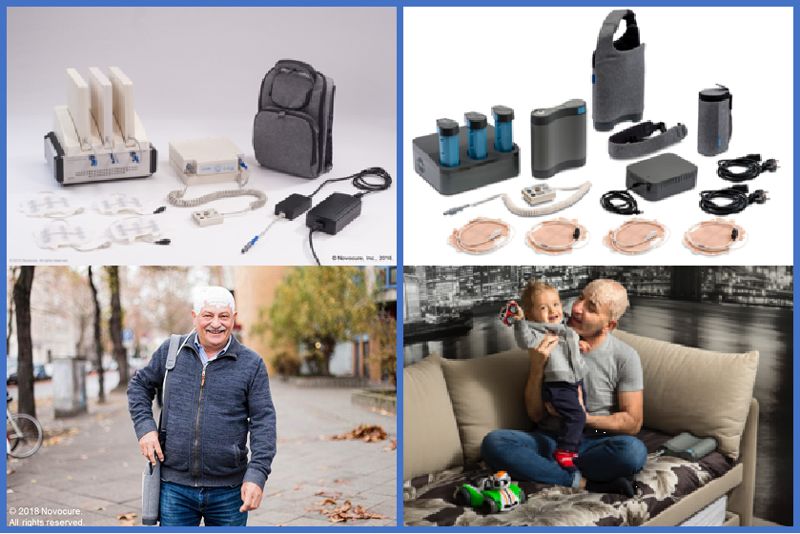The new Tumor Treating Fields therapy and the Optune device
The three most common types of brain cancer are meningiomas, which are mostly benign, intracranial metastases, and glioblastoma multiforme (GBM), which is the most common and lethal brain tumor in adults. Median survival in GBM according to treatment standards is approximately 15 months from the time of diagnosis. There are currently no curative therapeutic options for GBM and the standard treatment known as the Stupp protocol includes maximal surgical resection, radiotherapy (RT) and concomitant chemotherapy followed by maintenance chemotherapy. The efficacy of these therapies is limited by high recurrence rates, treatment-related toxicity, emerging resistance to therapy and neurological deterioration. There are few systemic therapies for GBM and temozolomide (TMZ) is the preferred first-line chemotherapeutic agent administered in combination with radiation therapy after surgical resection and treatment as maintenance therapy. The alternating electric field therapy known as Tumor Treating Fields (TTFields) is a new treatment method for GBM, developed and launched by Novocure. Treatment with TTFields has been found to offer clinical advantages for patients with GBM.
The TTField treatment method was invented by professor Yoram Palti (professor emeritus of physiology and biophysics at the Technion Israel Institute of Technology in Haifa, Israel) who realised that this method can interrupt cell division, leading to the death of cancer cells while saving healthy cells. Encouraged by preliminary results, he founded Novocure in 2000 to use this idea for cancer treatment.
Overall, the TTFields treatment has an anti-mitotic effect (mitosis is a process of asexual reproduction of cells thanks to which single cell splits in 2 genetically identical daughter cells) that can lead to cell death or the formation of abnormal cells destined to die quickly. TTFields can also inhibit DNA damage repair, compromise migration and cell invasion and improve autophagy. The resulting daughter cells exhibit various forms of cell death including immunogenic cell death, suggesting that the combination of TTFields with immunotherapies may improve the body’s anticancer immunity. In preclinical studies, greater sensitivity to chemotherapy in combination with TTFields has been demonstrated. There is also a synergistic effect reported between TTFields and radiotherapy, suggesting that patients with GBM may benefit from this combination.
TTFields therapy is given to patients with glioblastoma multiforme using at home the Optune device that delivers alternating electric fields through the array of transducers positioned on the patient’s shaved scalp. Optune devices are shown in the figure. With a weight of about 1 kg. Patients can perform normal daily activities during the treatment that must be administered for 18 hours a day to be effective.

The first encouraging pre-clinical data led to the start of a pilot clinical trial of 20 recurrent and newly diagnosed GBM patients in 2004 that validated the feasibility of treating GBM with TTFields. Four of the pilot study patients are still alive. The subsequent Phase III clinical trial proved the efficacy and safety of TTFields for GBM frequently verified approval by the US Food and Drug Administration (FDA) in 2011.
Novocure has launched a second phase III clinical trial for newly diagnosed GBM to test the efficacy and safety of TTFields in combination with maintenance TMZ. In 2015 and 2017 the intermediate and final results of the study showed that the addition of TTFields to the Stupp protocol improves progression free survival (PFS) and overall survival (OS) in new users with newly diagnosed glioblastoma multiforme. The addition of TTFields to maintenance therapy with TMZ improved the OS by approximately 5 months. Survival rates at two and five years for patients who received TTFields plus TMZ were recorded at 43% and 13%, compared to 31% and 5% for patients receiving TMZ only. These data led to FDA approval of TTFields therapy combined with TMZ for the treatment of newly diagnosed glioblastoma patients in 2015. A recent analysis that applied an integrated resistance model an incremental life survival of 1.8 years. Patients living in the second year after starting treatment with TTFields had a 20% chance of surviving the tenth year.
As targeted local and non-invasive therapy, TTFields has the advantage of avoiding systemic adverse events associated with chemotherapy and targeted systemic therapies. The adverse event associated with the primary treatment experienced by some patients with TTFields is skin irritation under arrays, which is predictable and easily manageable in most cases.
Unlike systemic cancer therapies, TTFields only act against rapidly dividing cancer cells when the patient wears the Optune device. As a result, the average daily use of the device is a crucial component of clinical benefit. Phase III GBM studies have shown that patients who reach 90% compliance show the maximum benefit with almost 30% still alive at five years.
Ongoing research is showing that the mechanism of action of TTFields has relevance in other tumors of the central nervous system, in numerous other solid tumors outside the brain such as mesothelioma, ovarian cancer and pancreatic and pleural adenocarcinoma.
In Italy the Optune device is available at the Besta Neurological Institute in Milan where a clinical trial is in progress.
I would love to add when you do not actually have an insurance policy or else you do not take part in any group insurance, you will well reap the benefits of seeking the aid of a health broker. Self-employed or those with medical conditions generally seek the help of the health insurance agent. Thanks for your text.